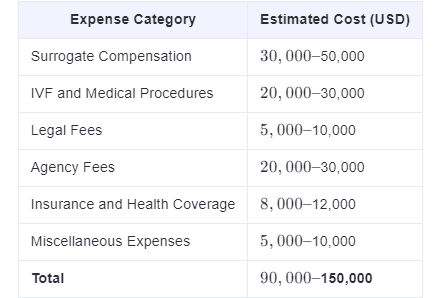In recent years, surrogacy has become an increasingly popular option for individuals and couples seeking to build or expand their families. With advancements in reproductive technology and growing global awareness of alternative family-building methods, more people are turning to surrogacy as a viable path to parenthood. However, one of the most common questions asked by prospective parents is: "Surrogate how much?"
This article aims to provide a comprehensive overview of the costs associated with surrogacy in 2025, including a breakdown of expenses, influencing factors, and tips for managing your budget. Whether you're considering surrogacy in the United States, Canada, Ukraine, or elsewhere, understanding the financial landscape is crucial for making informed decisions.
What Is Surrogacy?
Before diving into the costs, let’s briefly define what surrogacy entails. Surrogacy is a method of assisted reproduction where a woman (the surrogate) carries and delivers a baby for another person or couple (the intended parent[s]). There are two main types:
- Traditional Surrogacy: The surrogate uses her own egg, making her the biological mother of the child.
- Gestational Surrogacy: An embryo created via in vitro fertilization (IVF), using eggs and sperm from the intended parents or donors, is implanted into the surrogate. She is not biologically related to the child.
Due to legal and emotional complexities, gestational surrogacy is now the most widely accepted and practiced form globally.
Surrogate How Much? A General Cost Overview
The total cost of surrogacy can vary dramatically depending on location, medical needs, legal requirements, and personal choices. On average, the process can range from 90,000 to 150,000 USD in the United States, while international options may offer lower price points.
Here’s a general cost breakdown based on U.S. averages:


Key Factors That Influence Surrogate Costs
Understanding the question “surrogate how much?” requires looking beyond base prices. Several key factors influence the final cost of surrogacy:
1. Geographic Location
Different countries and even states within the U.S. have varying laws and regulations regarding surrogacy. For example:
- United States: Legal in many states but comes with high healthcare and agency fees.
- Canada: Altruistic surrogacy only; no payment for surrogates except reimbursement for expenses.
- Ukraine: Popular due to relatively low costs and clear legal frameworks.
- Greece & Georgia: Emerging destinations with competitive pricing.
2. Use of an Agency
Many intended parents choose to work with surrogacy agencies that help match them with surrogates, coordinate legal contracts, and manage logistics. While agencies add convenience and support, they also increase overall costs.
3. Medical and Fertility Treatments
The number of IVF cycles required, embryo transfers, and any additional fertility treatments (like genetic screening) can significantly affect the budget.
4. Surrogate Compensation and Benefits
Compensation varies based on the surrogate’s experience, whether she is carrying multiples, and her living situation. Some surrogates may also receive benefits like maternity leave, travel allowances, or bonuses for successful delivery.
5. Legal Fees
Surrogacy laws differ widely across jurisdictions. Legal fees cover drafting contracts, establishing parental rights, and ensuring compliance with local regulations.
6. Health Insurance
It’s essential to ensure the surrogate has adequate health insurance coverage. If not, intended parents must purchase a policy that covers pregnancy-related care, which can be costly.

Surrogacy Options and Their Associated Costs
There are several paths to surrogacy, each with its own financial implications:
1. Independent Surrogacy
Some intended parents choose to find a surrogate independently through online communities or personal connections. This route can reduce agency fees but often increases legal and logistical complexity.
2. Agency-Assisted Surrogacy
Working with a full-service agency offers peace of mind but adds significant costs. Agencies typically handle matching, screening, coordination, and support throughout the journey.
3. International Surrogacy
For those seeking more affordable options, international surrogacy programs (e.g., in Ukraine or Greece) may offer lower overall costs. However, these come with added risks such as political instability, language barriers, and post-birth passport/repatriation challenges.
4. Known Surrogacy (Family/Friend)
Using a close friend or relative as a surrogate can reduce some costs, particularly compensation and matching fees. However, it introduces potential emotional and relational dynamics that require careful handling.
Tips for Managing Surrogacy Costs
If you're asking “surrogate how much?”, here are practical ways to manage and potentially reduce your surrogacy expenses:
1. Explore Multiple Destinations
Research surrogacy-friendly countries and compare costs, legal protections, and success rates.
2. Consider Frozen Embryo Transfers
Fresh embryo transfers are more expensive than frozen ones. Discuss with your fertility clinic about the best approach.
3. Purchase Insurance Early
Ensure your surrogate has appropriate coverage or buy a policy early to avoid last-minute premium hikes.
4. Opt for Shared Agency Services
Some agencies offer partial services or shared case management to reduce fees.
5. Utilize Financing Options
Several fertility loan providers offer specialized financing for surrogacy, including fixed interest rates and flexible repayment terms.

Ethical Considerations in Surrogacy
While cost is a major concern, ethical considerations should not be overlooked. Surrogacy involves complex emotional, psychological, and social dimensions. Ensuring fair treatment, informed consent, and mutual respect between all parties is vital.
- Surrogate Rights: Surrogates should have autonomy over their bodies and access to independent legal counsel.
- Intended Parents’ Responsibilities: Intended parents must ensure fair compensation, emotional support, and transparency throughout the process.
- Child Welfare: The well-being of the child should always remain central to surrogacy arrangements.
Frequently Asked Questions About Surrogacy Costs
Q: Can surrogacy be done for free?
A: In some countries like Canada, surrogacy is altruistic and cannot involve payment beyond expense reimbursement. However, there are still significant out-of-pocket costs involved.
Q: Are surrogacy costs tax-deductible?
A: In the U.S., surrogacy-related medical expenses may be deductible under certain conditions, but surrogate compensation itself is generally not tax-deductible.
Q: Does insurance cover surrogacy?
A: Most standard health insurance policies do not cover surrogacy-related procedures. Specialized policies are usually required.
Q: How long does the surrogacy process take?
A: From matching with a surrogate to birth, the entire process can take 12–24 months, depending on legal processes and medical readiness.

Conclusion: Making an Informed Decision
The question “surrogate how much?” is just the beginning of a deeper exploration into the world of surrogacy. While the costs can seem daunting, understanding the components and preparing financially can make the journey smoother and more rewarding.
Whether you’re pursuing surrogacy domestically or internationally, working with professionals, or navigating the process independently, thorough research and planning are key. By approaching surrogacy with clarity, empathy, and preparation, intended parents can turn their dream of building a family into a beautiful reality.
Call to Action:
If you found this guide helpful, consider sharing it with others exploring surrogacy. For personalized guidance on surrogacy options and cost planning, reach out to our team today.
